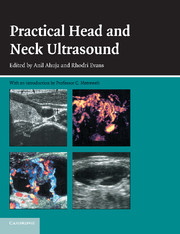Book contents
- Frontmatter
- Contents
- Contributors
- Introduction
- Acknowledgement
- CHAPTER 1 Anatomy and Technique
- CHAPTER 2 Salivary Glands
- CHAPTER 3 The Thyroid and Parathyroids
- CHAPTER 4 Lymph Nodes
- CHAPTER 5 Lumps and Bumps in the Head and Neck
- CHAPTER 6 The Larynx
- CHAPTER 7 What the Surgeon Needs to Know, and Why
- CHAPTER 8 Fine-Needle Aspiration or Core Biopsy?
- CHAPTER 9 Carotid and Vertebral Ultrasonography
- Index
CHAPTER 9 - Carotid and Vertebral Ultrasonography
- Frontmatter
- Contents
- Contributors
- Introduction
- Acknowledgement
- CHAPTER 1 Anatomy and Technique
- CHAPTER 2 Salivary Glands
- CHAPTER 3 The Thyroid and Parathyroids
- CHAPTER 4 Lymph Nodes
- CHAPTER 5 Lumps and Bumps in the Head and Neck
- CHAPTER 6 The Larynx
- CHAPTER 7 What the Surgeon Needs to Know, and Why
- CHAPTER 8 Fine-Needle Aspiration or Core Biopsy?
- CHAPTER 9 Carotid and Vertebral Ultrasonography
- Index
Summary
Introduction
In a chapter concerned with vascular ultrasound of the head and neck it would be pertinent to cover not only the carotid and vertebral arteries but other vessels such as the temporal, ophthalmic and ocular arteries. As space does not permit, this chapter is devoted to the carotids and vertebral, arteries. Furthermore, although there are many diseases that affect the arteries – including dissection, carotid body tumour, arteritis (tuberculosis, Takayasu's), and arteriovenous fistulae – the most common reason for examining the carotids and vertebrals is atheromatosis and its sequelae that lead to cerebral ischaemia. This chapter will therefore concentrate on this aspect of vascular ultrasound.
Ultrasound is non-invasive and more readily available than other techniques – digital subtraction angiography (DSA), computed tomography angiography (CTA) and magnetic resonance angiography (MRA) – and, uniquely, it can visualise the arterial wall itself. All other techniques are currently able to visualise only the lumen and provide very little information about the vessel wall. Ultrasound visualises the wall, the lumen and flowing blood. Doppler or colour flow techniques can provide dynamic information that indicates the haemodynamic effect of any abnormalities discovered. It also provides clues to intracranial disease when the extracranial arteries are normal, even when transcranial Doppler (TCD) or transcranial colour Doppler (TCCD) is unavailable.
Stroke is a significant public health problem, with an incidence of 2.9 per 1000 population in England and Wales with a recurrence rate of between 20% and 50% within 5 years. The estimated survival rate after a second stroke is only 40%.
- Type
- Chapter
- Information
- Practical Head and Neck Ultrasound , pp. 145 - 166Publisher: Cambridge University PressPrint publication year: 2000



